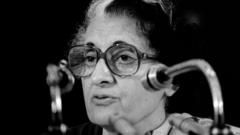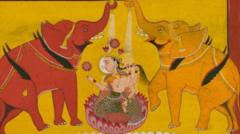**A look back at the Emergency declared by Indira Gandhi reveals its lasting impact on Indian democracy and civil liberties.**
**India's Dark Chapter: The Emergency of 1975**

**India's Dark Chapter: The Emergency of 1975**
**Reflecting on the 21-month suspension of democracy under Indira Gandhi**
At midnight on June 25, 1975, India, the world’s largest democracy, faced a chilling halt. Prime Minister Indira Gandhi proclaimed a nationwide Emergency, curtailing civil liberties, jailing opposition politicians, and undermining the press. This 21-month period transformed the nation into a façade of democracy, while true power lay in draconian governmental control.
The spark for this repressive move was a stunning ruling from the Allahabad High Court that invalidated Gandhi's election due to electoral misconduct. Confronted with the threat of disqualification and mounting public unrest led by veteran socialist Jayaprakash Narayan, she invoked Article 352 of the Constitution, claiming a need for order amidst national instability. Historian Srinath Raghavan notes that while the Constitution allowed for emergency powers, the application of these powers marked an unprecedented augmentation of executive authority, largely escaping judicial scrutiny.
Over 110,000 individuals were arrested, encompassing significant political adversaries such as Morarji Desai and LK Advani, as various groups from across the political spectrum were suppressed. Detainees faced overcrowded prisons, routine torture, and limited legal recourse, as courts remained largely ineffective during this tumultuous period—the higher judiciary offered little opposition to government mandates.
One of the most controversial aspects of the Emergency was a state-sponsored family planning initiative that estimated 11 million sterilizations, often forcibly executed. Allegations suggested that Sanjay Gandhi, Indira's son, orchestrated the program, exacerbating its unpopularity amongst the afflicted. Poor communities were particularly vulnerable, as coercive measures pushed many into surgical procedures.
In addition to civil rights violations, the Emergency facilitated a fervent urban cleansing strategy that dismantled approximately 120,000 slums and displaced 700,000 individuals in Delhi alone. A grave incident occurred in the Turkman Gate slum, where police violence led to fatalities, intensifying public outrage during government-led demolitions.
The press faced a complete transformation overnight as censorship muzzled journalistic freedom. On the eve of the Emergency, power outages rendered printers unable to operate, resulting in newspapers like The Indian Express and The Statesman printing blank spaces where editorials would normally reside. Even prominent foreign journalists were expelled, highlighting the lengths to which the government would go to suppress dissenting voices.
Similarly, Sanjay Gandhi’s program for the Youth Congress began implementing far-reaching social changes that merged his ideologies with government policy. Amidst this precarious scenario for industrial relations, trade unions faced a crackdown, and the labor landscape was realigned favorably towards industrialists, leading to improved productivity metrics.
Interestingly, while the Emergency is often viewed through the lens of oppression and chaos, some contemporaneous opinions noted a façade of order. Reports of efficiency emerged alongside tangible improvements in day-to-day operations—despite the underlying authoritarian stranglehold.
Historically, the Emergency is perceived as a momentary authoritarian blip that tested India’s democratic framework, yet this narrative casts a complacent attitude upon present-day politics. Historian Gyan Prakash warns that this interpretation may foster naive confidence in Indian democracy, eclipsing the precariousness of true democratic strength and the fragility of institutional checks.
The Emergency remains a poignant reminder of the perils of unchecked power, echoing BR Ambedkar's warnings about the dangers of unqualified devotion to a singular political figure. As India continues to navigate its democratic journey, the shadows of the Emergency serve as a historical touchstone for vigilance against the erosion of civil liberties.



















